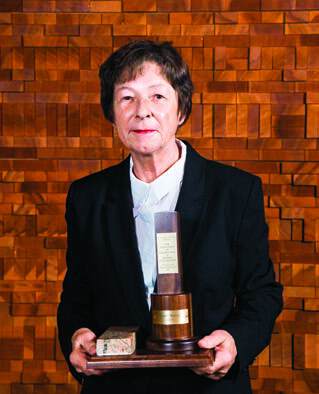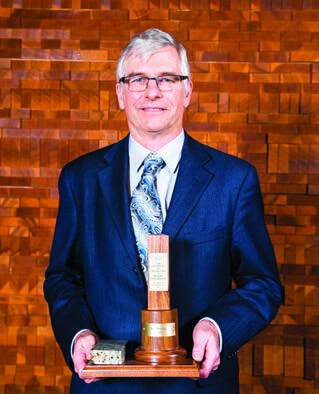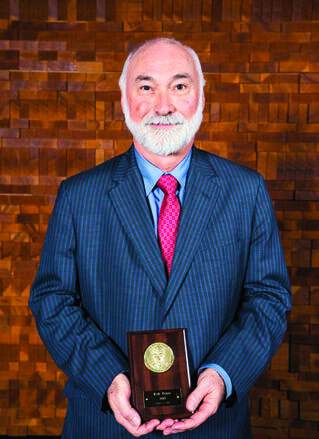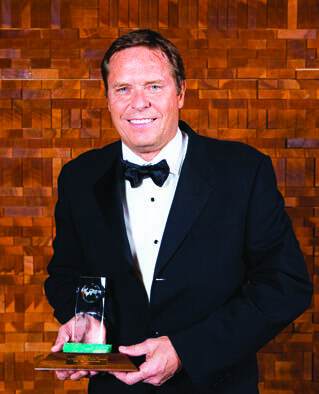AME BC honoured its 2015 award recipients on January 27 at Mineral Exploration Roundup 2016. Every January, the Association celebrates the important achievements made by leaders in the mineral exploration development community: in B.C., throughout Canada and internationally.
H.H. “Spud” Huestis Award
Excellence in Prospecting and Mineral Exploration
Recipients: Peter Bradshaw, Ron Britten and Ursula Mowat
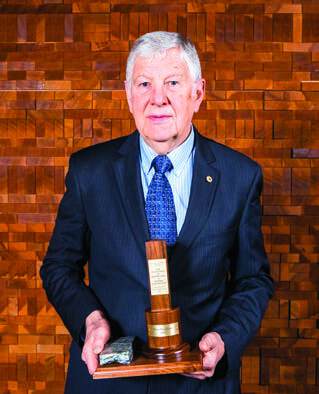
Peter Bradshaw 
Ursula Mowat 
Ron Britten
Peter Bradshaw, Ron Britten and Ursula Mowat are the recipients of the H.H. “Spud” Huestis Award for excellence in prospecting and mineral exploration in recognition of their efforts in identifying and commencing development of a new type of nickel deposit exemplified by the Decar project in central British Columbia. It is rare to identify a new deposit type and even more unusual to then become the first to significantly advance one.
Mowat, after graduating from the University of British Columbia with a B.Sc. in geology and then working for several mining companies, turned to prospecting in the Mount Sidney Williams ultramafic complex. She acquired claims over the complex in 1986, which she optioned to a series of junior companies exploring for gold over the next decade. Aware of the potential for chromite, nickel and platinum group elements, Mowat noted that petrographic PhD work from Peter Whittaker indicated the presence of a naturally occurring nickel-iron alloy called awaruite in several samples. She recognized the possibility for a bulk-tonnage, lowgrade nickel deposit and convinced Peter Bradshaw and Ron Britten of First ![Peter Bradshaw | Velour Productions/AME BC]() ![Ron Britten | Velour Productions/AME BC]() Point Minerals Corp. to joint venture her property. Exploration work in 1997 conducted by Mowat and funded by First Point was unsuccessful in recognizing awaruite mineralization and, because of the low price of nickel, the option was dropped the following spring.
In 2007, with a dramatic rise in the price of nickel, First Point – at this stage a two-man company – decided to review all historical and new data on awaruite and acquire claims over several awaruite-bearing ultramafic bodies in northern British Columbia, including the Decar nickel project near Mount Sidney Williams. Bradshaw, a geologist/ geochemist, had worked for the Royal School of Mines, Barringer Research Ltd., Placer Development Ltd. and Orvana Minerals Corp., while Britten, an economic geologist, had worked with Sumitomo Corp., Esso Minerals and Homestake Mining Co.
A major problem was how to analyze for the percentage of total nickel that was present as awaruite. Bradshaw studied how nickel was partitioned between silicates, sulphides and awaruite to develop a unique geochemical method to determine the nickel-in-alloy. In 2008, while working on the Josephine complex in Oregon, Bradshaw found a method described in a thesis and also a different method in a Japanese reference to that thesis that purported to be selective extractions for awaruite. The former proved unusable and the latter extracted both awaruite and nickel sulphides, although not nickel in silicates. First Point funded successful research at Acme Labs to develop a suitable method, which led to the selective extraction being certified by an independent third party. This extraction procedure proved to be an effective and valuable tool for analyzing both rock and stream sediments during the initial exploration work and other properties. Bradshaw also guided metallurgical work on how to concentrate awaruite as well as the assessment of Decar’s economic potential.
Britten designed exploration programs for awaruite and focused on understanding the controls of awaruite abundance and grain size distribution throughout the Mount Sidney Williams complex. His leadership led to the definition of nickelmineralized zones for this new type of deposit – the first potentially economic resource identified around the globe. Cliffs Natural Resources optioned the Decar property from First Point in 2009.
From the beginning, First Point was interested in exploring for awaruite nickel deposits at a number of locations. The company’s efforts have produced a working model that permits the identification of prospective areas for awaruite formation along with the tools required to identify and undertake preliminary evaluation of these occurrences. The results of this work can be applied worldwide in similar geological settings.
E.A. Scholz Award
Excellence in Mine Development
Recipients: Rob Pease and Scott Shellhaas

Rob Pease 
Scott Shellhaas
Rob Pease and Scott Shellhaas are the recipients of the E.A. Scholz Award for excellence in mine development. These individuals led two separate teams that were responsible for advancing the Mount Milligan copper‐gold project in central B.C. through development to production from 2006 through 2013.
Mount Milligan was discovered in the late 1980s, but the path to production began in earnest in 2002 when Pease, working for property owner Placer Dome Inc., initiated a metallurgical drilling campaign. Studies continued through 2005 specifically focusing on metal recoveries – one of the most challenging fields of study for the project – at a time when commodity prices were significantly improving. Placer Dome began to consider the project a high priority for development, but momentum stumbled in late 2005 when Barrick Gold and Goldcorp made a joint offer to acquire Placer Dome. Undeterred, in early 2006, Pease set out on his own and was part of a group of investors that arranged to purchase Mount Milligan and other Canadian projects for $120 million in preferred shares of a company ![Scott Shellhaas | Velour Productions/AME BC]() that would become Terrane Metals.
Terrane, with Pease as president, resumed driving Mount Milligan toward development. From mid-2006 through early 2010, Terrane completed several feasibility-related studies on the project. The project received federal and provincial environmental assessment approvals while concurrently achieving significant progress with First Nations and local communities. Then, in mid-2010, corporate events once again provided change as Terrane was acquired by Thompson Creek Metals for approximately $700 million in cash and shares. Shellhaas was chief operating officer of Thompson Creek Metals and the following year he was appointed president.
Shellhaas immediately took the torch from Pease to push the project onward, with Thompson Creek raising construction capital through selling gold streams from Mount Milligan, as well as completing equity and debt financing. This facilitated the team led by Shellhaas to construct the project and complete all necessary operational readiness matters. Of significant note is the safety performance during mine construction that recorded over five million hours worked without a lost-time incident. The mine commenced operations and ramp-up in late 2013. The Mount Milligan project is built to the highest standards and has reserves for more than 22 years. Significant additional defined resources have the potential to add several more years of mine life. The succession of teams led by Pease and then Shellhaas were critical in bringing this project to fruition. Both of these men were successful because of a team effort – teams that they formed, directed and led. They are consummate professionals with vision, capacity and drive, the type of people who make things happen no matter how tough the challenge.
Murray Pezim Award
Perseverance and Success in Financing Mineral Exploration
Recipient: Clive Johnson
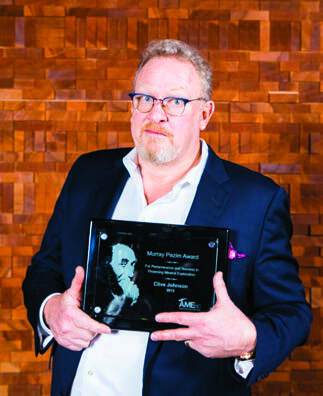
Clive Johnson is the recipient of the Murray Pezim Award for perseverance and success in financing mineral exploration. He is recognized for his roles in financing mineral exploration companies including Eldorado Gold Corp., Bema Gold Corp. and B2Gold Corp. As a founder of Eldorado and throughout his management roles with Bema and B2Gold, Johnson has raised approximately $5 billion through a combination of equity and debt financings. The capital raised has helped turn Bema and B2Gold from junior explorers into intermediate mining companies and, in the process, helped to create thousands of jobs that brought wealth to numerous communities worldwide. This is a truly amazing accomplishment regardless of timing in the commodity cycle and, as such, distinguishes Johnson as a worthy recipient of the award.
Johnson’s formal education began at university but soon took an alternative path: running a bush crew staking claims in Yukon. After a few years, Johnson got together with a few partners and started a mining company, which, through an amalgamation with several other companies, ultimately became Bema Gold Corp. Upon this amalgamation, Johnson was appointed president and CEO and never looked back. Some of his early work at Bema included raising capital for the construction of the Champagne Mine in Idaho during 1989, in very tough market conditions. Johnson was successful in raising $5 million for this purpose, and the mine was completed and operational the next year. Bema subsequently continued to finance and develop mines and fund exploration in Canada, Chile, Venezuela, South Africa and Russia. Some of the more notable projects in which Bema was involved included Refugio, Cerro Casale and Julieta. This culminated in Bema securing the high-grade Kupol gold project in Russia, for which it raised over $500 million from 2003 to 2006 and built the mine a full year ahead of schedule. In 2006, Bema was acquired by Kinross Gold Corp. for $3.5 billion.
Following his involvement with Bema, Johnson managed to keep most of his team together and co-founded B2Gold Corp. in 2007, for which they raised $100 million in an IPO. A year later, B2Gold made a takeover offer on a distressed company, Central Sun Mining Inc., with assets in Nicaragua. B2Gold subsequently developed two mines in Nicaragua, La Libertad and El Limon, which formed the backbone of cash flows that allowed the company to make the subsequent acquisitions of Auryx Gold Corp. and CGA Mining Ltd., in addition to the associated investments required to develop the assets they acquired.
Johnson’s perseverance and success in financing mineral exploration has enabled him to build two multibillion-dollar gold-mining companies from scratch while operating in regions that would test the best-run businesses. Johnson and his team’s legacy continues with B2Gold Corp., which currently operates major exploration, development and mining projects in Nicaragua, the Philippines, Namibia, Burkina Faso, Mali and Colombia.
Hugo Dummett Diamond Award
Excellence in Diamond Exploration and Development
Recipient: Eira Thomas

Eira Thomas is the recipient of the Hugo Dummett Diamond Award. Thomas has been an integral player in the Canadian diamond industry for over 20 years, starting with her well-documented involvement in the discovery and evaluation of the Diavik kimberlites in 1994. Her involvement and leadership within the Canadian diamond sector extends well beyond that transformative discovery. Thomas has made a number of significant contributions toward diamond exploration, discovery and mine development throughout her career – not the least of which is the elevated profile of Canadian diamonds and the diamond mining industry.
Through her various industry associations that include Aber Resources Ltd. (now Dominion Diamond Corporation), Navigator Exploration Corp., Stornoway Diamond Corporation, Lucara Diamond Corporation and North Arrow Minerals Inc., Thomas has been involved with the evaluation and development of kimberlites in the Northwest Territories, Nunavut, A lberta, Saskatchewan, Ontario, Quebec, Greenland and Botswana. This work has resulted in the discovery of four new kimberlite fields (three in Nunavut and one in Saskatchewan), and numerous additional kimberlites in at least six other areas in the Northwest Territories, Nunavut, Ontario and West Greenland.
Thomas has truly seen the sector from all angles; she started working in the field as an exploration geologist, and then moved on to manage exploration programs as vice-president of exploration at Aber Resources (now Dominion Diamond Corporation) and co-found two diamond companies, Stornoway and Lucara. She has actively pursued, championed and financed early grassroots exploration, kimberlite discovery and evaluation and diamond mine development in Canada and abroad. The ultimate objective for mineral exploration is the successful development of a mine, and Thomas has been involved in the evaluation and development of at least three diamond mines including Diavik (Northwest Territories), Renard (Quebec) and Karowe (Botswana).
Thomas is well known throughout the worldwide diamond community by geoscientists, project developers, marketers, cutters and investors. She is often sought after for her broad perspective on the diamond industry, and she has, through numerous media reports over the years, presented a positive voice for responsible and sustainable mineral development. She has been a tireless supporter of and spokesperson for the mining industry through her involvement in numerous advocacy groups and regulatory advisory bodies.
Colin Spence Award
Excellence in Global Mineral Exploration
Recipients: Joe Piekenbrock and Rick Van Nieuwenhuyse

Joe Piekenbrock 
Rick Van Nieuwenhuyse
To be truly successful in exploration, one needs to first pick the right project, understand how geoscience can be used to build truly predictive models to recognize ore controls, and have a willingness to work tirelessly to achieve one’s goals. Joe Piekenbrock and Rick Van Nieuwenhuyse understand these principles and that is the reason they have had career-long success. It is for these achievements that they are being recognized as the recipients of the Colin Spence Award for excellence in global exploration. More specifically, they are being acknowledged for their highly successful application of predictive geologic modelling techniques in Alaska – defining and significantly expanding the Donlin Creek gold deposit in western Alaska and the Arctic copper-zinc-silver massive sulphide deposit in the Ambler Mining District, as well as discovering and exploring the high grade Bornite copper deposit.
Piekenbrock attended the University of Colorado in his home state before earning a M.Sc. in geology from the University of Arizona in 1983. After graduation, he joined Cominco American Inc. and the very successful regional Alaskan exploration team whose discoveries are numerous, including the giant Pebble porphyry copper deposit. Piekenbrock left Cominco in the late 1980s and operated as a consultant in Nevada during the Great Basin gold boom before joining up with Van Nieuwenhuyse at Placer Dome. In 1996, Piekenbrock left Placer Dome to start Brett Resources Inc. and build a portfolio of exploration properties in Peru and Central America. Returning to the United States in 1999, he joined Van Nieuwenhuyse as vice-president of exploration for NovaGold Resources Inc. in 2001 and subsequently NovaCopper Inc. in 2012.
Van Nieuwenhuyse grew up in Alaska and undertook undergraduate studies in Belgium and Michigan before obtaining a M.Sc. in geology from the University of Arizona in 1980. His professional career started with Anaconda Copper Mining Company before working for FreeportMcMoRan Inc., Atlas Precious Metals Inc., Nautilus Exploration and Placer Dome. In 1998, Van Nieuwenhuyse became CEO of NovaGold and, over the following 14 years, built it into a junior powerhouse through the advancement of Donlin Creek, Galore Creek in northwestern B.C., and the Arctic and Bornite projects in the Ambler Mining District. In 2012, the Ambler assets were spun out to NovaCopper with Van Nieuwenhuyse as CEO.
To be associated with any significant mineral development is a career achievement for most geoscientists, but what makes this duo remarkable is that the Donlin, Ambler and Galore Creek projects are truly world class, yet are diverse in geologic terrain and deposit type. As well, Piekenbrock and Van Nieuwenhuyse understood that meaningful community and indigenous relationships had to be incorporated into their exploration plans, and they set about forging groundbreaking agreements with the Calista Corporation and NANA Regional Corporation in Alaska and the Tahltan Nation in British Columbia.
Robert R. Hedley Award
Excellence in Social and Environmental Responsibility
Recipient: Patrick McAndless
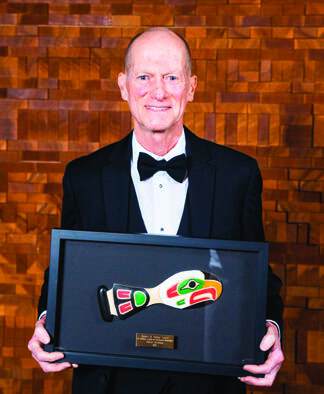
Patrick McAndless is the recipient of the Robert R. Hedley Award for excellence in social and environmental responsibility. McAndless is recognized for his passion and talent in mentoring young professionals and his commitment to advancing the human capital of the mineral exploration and mining sector. His efforts have positively impacted the lives of hundreds of individuals and communities in B.C., across Canada and beyond.
Through his long career as an exploration geologist, much of it spent as the vice-president of exploration for Imperial Metals Corp., McAndless recognized that the cyclical nature of the industry can create wide gaps in talent and make it difficult for recent graduates and young professionals to build a career. Over more than a decade he has given presentations at more than 100 universities and colleges on opportunities in mineral exploration and mining. At each location he takes on several new students; he mentors them in their education and careers, and he provides guidance in resumé building and networking so they are prepared to enter the industry. Many of these students comment on his passion for people, geoscience and exploration, as well as for social and environmental excellence in the mining industry.
In addition to mentoring individuals, McAndless serves on the industry advisory committees for both Northwest Communit y College’s School of Exploration and Mining and the British Columbia Institute of Technology’s Department of Mineral Exploration and Mining. In this capacity, he provides his expertise and technical support as an exploration geologist to ensure students are learning the most up-to date and relevant topics for today’s industry.
McAndless is tireless in advocating for the mineral exploration and mining industry and for growing the next generation of industry professionals. His ability to recognize the potential of young people and mentor them to achieve that potential is commendable. In the words of one of those young people, he is deserving of this award simply for the depth of his humanity.
David Barr Award
Excellence in Leadership and Innovation in Mineral Exploration Health and Safety
Recipient: Lise Tompson-Cyr

The late Lise Tompson-Cyr is the recipient of the David Barr Award for excellence in leadership and innovation in mineral exploration health and safety. TompsonCyr had an intimate knowledge of the mineral exploration work environment across Canada, beginning in 1980 when she moved from Quebec to become a bush camp cook in northern Yukon. She married a helicopter pilot and spent the next 10 years working in exploration camps. In 1984 she started up a company, 1984 Inc., to staff and run bush camps. An important part of the services provided was training and supplying of first-aid attendants. In 2006, Tompson-Cyr was instrumental in forming a Cambridge Bay, Nunavutbased joint venture called 1984 Nunavut Ltd. This majority-Inuit-owned company became a leader in the training of a mainly Aboriginal workforce to supply mineral exploration camps in northern Canada.
Tompson-Cyr was also an enthusiastic and inspiring member of the health and safety committees of both the Prospectors & Developers Association of Canada (PDAC) (2006 to 2014) and AME BC (2004 to 2007). She generously shared her knowledge of the exploration environment in Canada, whether it was to do with camp management, drilling, helicopters or personnel safety in camp. As her company worked in most provinces and territories of Canada, she had an excellent knowledge of jurisdictional variation in regulations. She had an immense knowledge of accidents, their causes and their prevention. She made a significant contribution to the 2006 revision of AME BC’s Safety Guidelines for Mineral Exploration in Western Canada and provided support when the PDAC e3 Plus Health and Safety in Exploration Toolkit was written. She was also instrumental in developing the Canadian Mineral Exploration Health & Safety Survey. Tompson-Cyr’s drive also created a successful company where the safety of mineral exploration personnel was ingrained in its culture because of her leadership.
Gold Pan Award
Exceptional Meritorious Service to the Mineral Exploration Community Through the Association for Mineral Exploration British Columbia
Recipient: Lindsay Bottomer
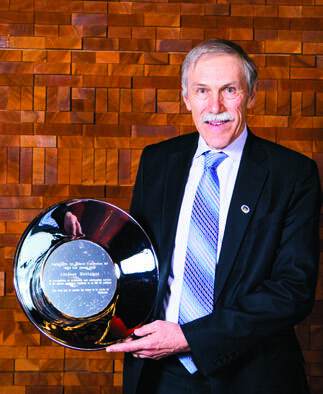
The Gold Pan Award is presented to Lindsay Bottomer. Bottomer has served AME BC for more than 20 years, and began volunteering for the Association soon after his arrival from Australia in 1989 as a member of Murray Pezim’s Prime Capital Corp. Bottomer served on the board of directors from 1993 to 2005 through a challenging period for mineral exploration in British Columbia and a gradual upswing. After serving as vice-president from 1995 to 1998 (during which time he was also the technical session chair for the Roundup Committee), he was president of the Association from 1998 to 2000. Bottomer has also dedicated his time to a number of AME BC committees over the years, including the Finance and Audit (on which he has served for nearly 20 years), Geoscience, Honourary Advisory Board Liaison and Roundup Organizing committees. Bottomer has also been active with the Association of Professional Engineers and Geoscientists of B.C.
Frank Woodside Past Presidents and Chairs Award
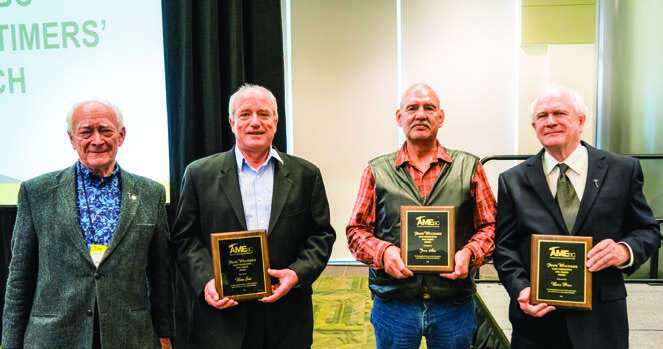
The Frank Woodside Past Presidents and Chairs Award is presented to three individuals.
Jerry Asp is committed to enhancing the quality of life for Aboriginal people through the creation of new business opportunities and the development of skills and capacity in the community. Asp is an experienced consultant and negotiator, and one of his early achievements was the first significant impact and benefits agreements for a mine in British Columbia. In 2010, Asp was awarded the Prospectors & Developers Association of Canada’s Skookum Jim Award, which recognizes Aboriginal achievements in the mineral industry. He is also vice-president of the Canadian Aboriginal Minerals Association. From 2006 to 2009, Asp was a member of AME BC’s Stepping Stone Editorial Board.
Barry Price is president of B.J. Price Geological Consultants. He is recognized as B.C.’s leading nephrite jade geoscientist and is also active in copper-gold porphyry exploration. Price has extensive experience in valuation of exploration properties and B.C. government expropriations. He holds both bachelor’s and master’s degrees in geology from the University of British Columbia, and is one of the leaders behind a fundraising campaign to revitalize the UBC Geological Field School near Oliver, B.C.
Hans Smit specializes in guiding advanced exploration projects through resource estimations, economic evaluations and permitting. He is president of the Minerals North board of directors and has been involved on many boards and committees as a mineral exploration representative. As former vice president of exploration for Grayd Resource Corp., Smit played an instrumental role in the discovery and advancement of the La India project in Sonora, Mexico, which entered production in 2014. Smit served on the AME BC board of directors from 1999 through 2007; during this time he also served on the AME BC Land Use Committee.
AME BC Outreach Education Fund
The AME BC Outreach Education Fund is a corporate endowment dedicated to increasing the public’s appreciation and understanding of B.C.’s mineral exploration industry through the advancement of public education and community programs.
The Britannia Mine Museum is granted $5,800 towards supporting the museum’s education programs, which in 2015 accommodated 11,500 students from kindergarten to Grade 12. More specifically, the 2016 program will be focused on evaluating and updating the What Uses Are Minerals to Me program and the newly established Sea to Sky Geotour program, as co ordinated with Don Ross Middle School in Brackendale. A new initiative will be developed to showcase specific metals in various minerals and in our water resources. This exhibit is scheduled for display from March to August of 2016. Also, a classroom/learning zone has now been completed at the museum where students will have hands-on experience with minerals, rocks and metal specimens. The museum has also recently received an impressive collection of hydrothermal black smoker chimney specimens from the Juan De Fuca Ridge. The specimens will, in the near future, be showcased as an exciting display to demonstrate how these underwater hydrothermal events related to the formation of the Britannia copper orebodies.
The Centre of Training Excellence in Mining (CTEM) is granted $4,600 for costs related to co-ordination and production of the second edition of BC Career Pathways Guidebook: Mining Careers. CTEM was created in 2013 with the aim of providing British Columbians access to education and training programs specifically focused on careers in the mineral exploration and mining industries. A wellillustrated and informative guidebook was prepared and distributed in 2014 with the objective of communicating to prospective students, jobseekers and the general public about opportunities in prospecting, exploration and development, operations and reclamation projects in B.C. In order to further advance the public’s appreciation and understanding of B.C.’s mineral exploration and mining industries and their related career opportunities, CTEM is planning to update and produce an enhanced version of the guidebook. It is anticipated that this edition will provide new perspectives and information on trades, career paths and education programs. It is also hoped that the second edition will be distributed to a broader B.C. audience, including Aboriginal and remote communities.
MineralsEd is granted $9,600 for coordinating the Kids and Rocks hands-on classroom workshop in 2016 for children and students in kindergarten to Grade 3 in the Lower Mainland schools of B.C. The main objective of this program is to introduce children to the basic properties of various rocks and minerals and how they are utilized to benefit our lives. The kids are very interested, curious and eager to learn about our earth and its materials. They are provided with a bag of about 25 rocks and minerals along with a hand lens, hardness kit, streak plate, magnet and flashlight to experience and learn the basic physical properties of their specimens. As the children advance, they are introduced to how our daily lives are dependent on the earth’s non-renewable resources. In 2015, the funding grant provided for the delivery of the hands-on workshop to 25 classes totalling 548 children. This Kids and Rocks project is an important steppingstone in the foundation and future of our mineral exploration industry.

